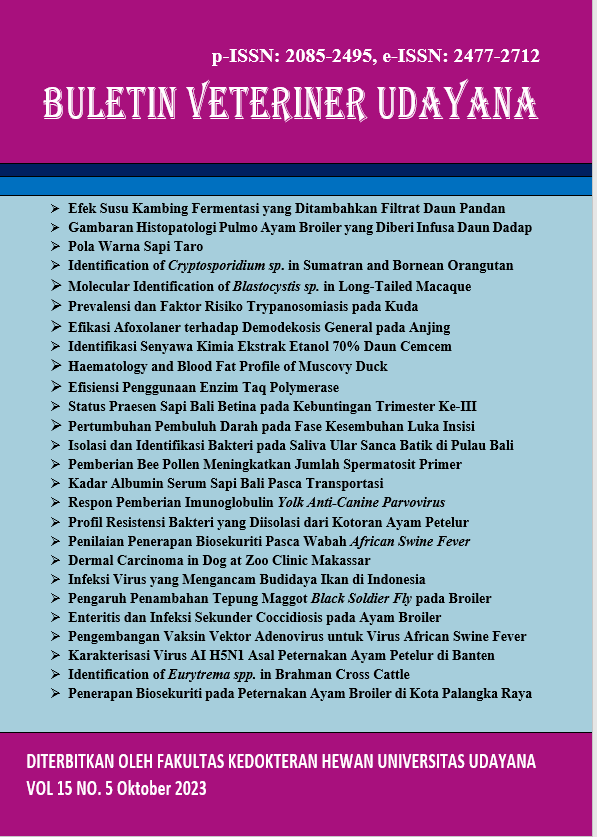MOLECULAR IDENTIFICATION OF BLASTOCYSTIS SP. IN LONG-TAILED MACAQUE AT ALAS PURWO PARK
Abstract
Zoonotic diseases can be transmitted through close interactions between long-tailed monkeys. Blastocystis sp. is one of the parasites that can attack mammals and is most commonly found in the intestinal tract. This study aims to analyze the presence of infection and the phylogenetic tree of Blastocystis sp. in long-tailed monkeys in Alas Purwo National Park, Banyuwangi, East Java. Identification of Blastocystis sp. in this study using morphological and molecular methods. A total of 100 stools were examined microscopically using the floating method, showing that 61 samples were positive, followed by a PCR test with a target of 600bp. PCR results obtained three positive samples followed by squencing. Sequences processed in BLAST isolate samples TNAP2 and TNAP9 having homology with Blastocystis sp. Subtype 3 was 98-99%, while the TNAP7 isolate had a lower homology level of 78-79% and the level of phylogenetic analysis of the TNAP2 and TNAP9 isolates was related to Blastocystis sp. from the Philippines (KY610153.1) and Egypt (OP942294.1) and the TNAP7 isolate is related to Blastocystis sp. from Thailand (MH197670.1, MH197668.1). Isolate Blastocystis sp. from Alas Purwo National Park has high homology analysis results to Blastocystis type hominis from Rep. Czech and Chinese by 80-99%, it is possible to have a connection with the zoonotic problem.
Downloads
References
Alfellani MA, Jacob AS, Perea NO, Krecek RC, Taner-Mulla D, Verweij JJ, Stensvold CR. 2013. Diversity and distribution of Blastocystis sp. subtipes in non-human primates. Parasitol. 140(08): 966-971.
Arpitha GMC, Sreekumar C, Latha BR, Bharathi MJ. 2018. Prevalence and staining characteristics of blastocystis isolates from food animal in Tamil Nadu. Vet. Parasitol. 11: 61-65.
El Safadi D, Gaayeb L, Meloni D, Cian A, Poirier P, Wawrzyniak I, Delhacs L, Seck M, Hamze M, Riveau G, Viscogliosi E. 2014. Children of senegal river basin show the highest prevalence of Blastocystis sp. ever observed worldwide. BMC Infect. Dis. 14: 164-174.
Friishansen M, Hariyawan AW, Supriyanto S, Damanik AR. 2015. The interactions between long-tailed macaques (Macaca fascicularis) and tourists in Baluran National Park, Indonesia. J. Indon. Nat. History. 3: 36-41.
Kurniawati DA, Suwanti LT, Lastuti NDR, Koesdarto S, Suprihati E, Mufasirin, Pratiwi A. 2020. Molecular identification of Blastocystis sp. in long-tailed macaque (Macaca fascicularis) at Baluran National Park, Situbondo, East Java. Med. Vet. J. 3(2): 138-144.
Mahendra D, Suwanti LT, Lastuti NDR, Mufasirin, Suprihati E, Yuniarti WM, Widisuputri NKA. 2020. Molecular detection of Blastocystis infection in pigs at tabanan and badung district, bali province, indonesia. Vet. J. 21(2): 227-233.
Osman M, Bories J, El-Safadi D, Poirel MT, Gantois N, Benamrouz-Vanneste S, Delhaes L, Hugonnard M, Certad G, Zenner L, Viscogliosi E. 2015. Prevalence and genetic diversity of the intestinal parasites Blastocystis sp. and Cryptosporidium spp. in household dogs in france and evaluation of zoonotic transmission risk. Vet. Parasitol. 214: 167-170.
Ramírez JD, Flórez C, Olivera M, Bernal MC, Giraldo JC. 2016. Blastocystis subtyping and its association with intestinal parasites in children from different geographical regions of Colombia. PLoS ONE. 12(2): e0172586.
Scanlan P, Stenvold CR, Rajilic-Stojanovic M, Heilig HG, Devos WM, O’Toole PW, Cotter PD. 2014. The microbial eukaryote Blastocystis is a prevalent and diverse member of the healthy human gut microbia. FEMS Microbiol. Ecol. 90(1): 326-330.
Stensvold CR. 2013. Comparison of sequencing (barcode region) and sequence-tagged-site PCR for Blastocystis subtyping. J. Clin. Microbiol. 51(1): 190-194.
Yoshikawa H, Wu Z, Pandey K, Pandey BD, Sherchand JB, Yanagi T, Kanbara H. 2009. Molecular characterization of Blastocystis isolates from children and rhesus monkeys in Kathmandu, Nepal. Vet. Parasitol. 160(3-4): 295-300.
Zhu W, Tao W, Gong B, Yang H, Li Y, Song M. 2017. First report of Blastocystis infections in cattle in China. Vet. Parasitol. 246: 38–42.





